This report covers:
- Changes
- Oops!
- Scoped
- Old Condor tank
- Sight-in
- Taking my time
- 6 more shots
- The test
- I shot three different pellets
- Filled before the test of each pellet
- JTS Dead Center 18.1-grain dome—no silencer
- JTS Dead Center 18.1-grain dome—Ronin silencer
- JTS Dead Center 18.1-grain dome—TalonP silencer
- Discussion
- Summary
Today we begin looking at the accuracy of the AirForce Condor with the Fast Attachment Thread System (FATS) and two silencers. Let’s begin because there is a LOT to test!
Changes
AirForce changed the barrel on my Condor to attach the FATS—simply because over the decades the Condor has been in production there have been manufacturing changes to the rifle. Specifically, the barrels are now ground to a diameter that might be different than the barrel in my 2004 Condor. I say “might” because there is a small chance for a size difference.
More importantly, though, the barrel bushings have changed from Delrin to aluminum and they have gotten holes for any energized air to pass through. You can see that in Part 1 if you don’t remember. That allows the whole barrel shroud to be used to quiet the shot. And on that account I have a big Oops coming! Anyway—a new barrel means a new accuracy potential.
Oops!
When I started this test I knew I had to record the Condor’s power setting, since this rifle has a power adjustment wheel. And when I went to set it, I discovered that the wheel was set as low as it would go. That means the sound test I did in Part 2 is invalid and has to be run again. I couldn’t run the sound test on the AirForce indoor range because the steel walls reflect too much noise.
Scoped
I also had to mount a scope on the rifle as it did not have one. I have more airguns than scopes so I’m continually changing optics for tests. A new scope means a sight-in and an accuracy test. It’s like I’m testing a brand new air rifle.
I mounted a Meopta 3-15X50 RD second focal plane scope. Since it’s a second focal plane at least I won’t have to struggle with changing reticle sizes. And I know I can trust this scope.
Old Condor tank
When they installed the new barrel AirForce asked if I also wanted to upgrade to the newer Condor tank that has a gauge and can be filled while still on the rifle. I was very tempted because the new tank is so much easier to work with but that would change all my previous velocity testing, so I elected not to. I may regret that decision later. But I guess I can always change.
Sight-in
I sighted in at 12 feet and got the JTS Dead Center 18.1-grain pellet where I wanted in three shots. If I was testing the rifle at home that would be no great issue because I could always fix things if they went wrong, but I asked to use the AirForce 100-yard tunnel to test this rifle. That means I will be at AirForce—away from all my support equipment. The scope’s gotta work right and be sighted in correctly or the test ends.
Taking my time
I’m testing a Condor with a new barrel, so I know very little about the rifle’s accuracy potential. I’ll get used to the trigger again and watch the air use with the old tank, which is why I chose to keep it. Today I have to:
1. Get the rifle grouping on paper.
2. Discover pellets that are accurate.
3. Test it with no silencer.
4. Test it with the AirForce TalonP silencer.
5. Test it with the DonnyFL Ronin silencer.
I have to do that all at 25 yards before I try to move out farther. That’s a lot of stuff to do when I’m away from my support base. So today will be the first of probably several accuracy tests with this FATS. AirForce has a 25-yard range inside their building, and before I go to their 100-yard tunnel I want to be sure I know the rifle as much as possible. And the AirForce range is a true 25 yards.
6 more shots
It took six more shots of the same JTS pellet at 25 yards to get into the black. Then I started the test.
The test
I shot five-shot groups with each pellet, first with the rifle not silenced, then with the DonnyFL Ronin silencer on and finally with the TalonP silencer on. I set the power setting to 10, which experience with the tank and valve on the rifle have taught me give the best return of power and shot count. Not the most power—the best return for both power and shot count.
The rifle was held in a vise for all shots! This marks the first time in history I have shot a rifle that was held in a vise. It did make things easier, but as far as I can tell the accuracy was not improved.
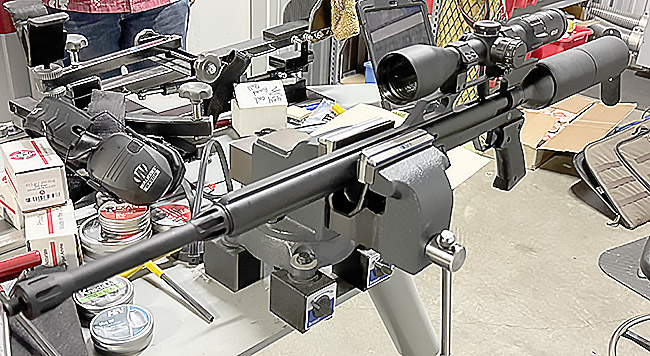
Yes, BB Pelletier finally put an air rifle into a vise. Does that make you happy?
I shot three different pellets
Because I wanted to test the accuracy without a silencer and also with each of the two silencers (DonnyFL Romin and TalonP silencers) I shot five-shot groups. There are nine different targets to view. I only put the dime and pellet on the target that had no silencer. Let’s look at the first test.
Filled before the test of each pellet
I know my Condor tank and valve will get 20 good shots at power setting 10. Since each pellet will be shot 15 times, I filled before each test.
JTS Dead Center 18.1-grain dome—no silencer
With no silencer the 18.1-grain JTS Dead Center dome went into 0.282-inches at 25 yards. That’s pretty good and it means the barrel AirForce installed in my rifle is a good one. Also the 18.1-grain JTS Dead Center pellet works in this rifle.
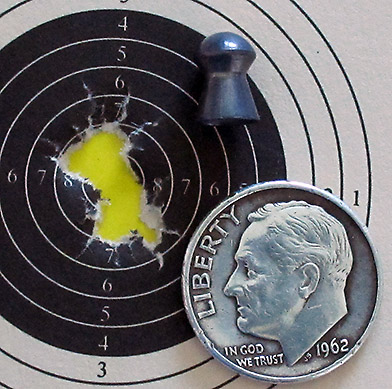
With no silencer attached the Condor put five 18.1-grain JTS domes into 0.282-inches at 25 yards.
JTS Dead Center 18.1-grain dome—Ronin silencer
With the Ronin silencer the Condor became slightly more accurate, putting five JTS pellets into an incredible 0.203-inches at 25 yards. Now, the silencer didn’t actually increase accuracy. It just didn’t take anything away and I got lucky with this group.
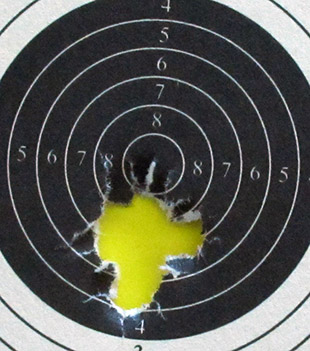
With the Ronin attached the Condor put five JTS pellets into 0.203-inches at 25 yards.
JTS Dead Center 18.1-grain dome—TalonP silencer
When the TalonP silencer was attached the Condor put five JTS pellets into a 0.23-inch group at 25 yards. That’s very close to what the Ronin did.
The TalonP silencer put 5 JTS pellets into 0.23-inches at 25 yards.
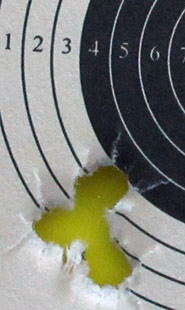
The TalonP silencer put 5 JTS pellets into 0.23-inches at 25 yards.
Discussion
So far we have learned several things. First, we now know this AirForce Condor is accurate. I knew my old Condor barrel was accurate and these are Lothar Walther barrels so there was no reason to expect anything different, but now we know for sure.
Next, we know that the JTS 18.1-grain Dead Center dome is an ideal pellet for this rifle—at least at 25 yards. All three groups were small and reasonably close in size to each other, which is consistency we like to see.
We also know that the rifle remains accurate when either of the two silencers is attached. I checked both silencers to see if there were any lead scrapings and there were none. That means the Fast Attachment Thread System aligns with the barrel. If it didn’t it wouldn’t be worth much, and since it is an optional attachment it had to be tested. I think the FATS is a worthwhile accessory.
Summary
I’m going to end today’s report here because it will be too long otherwise. I need some time to explain things as we go—like the Oops that was mentioned. The next report will complete this test and will have a small surprise.
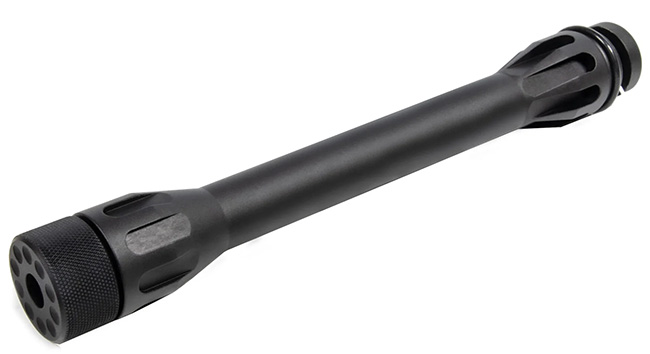
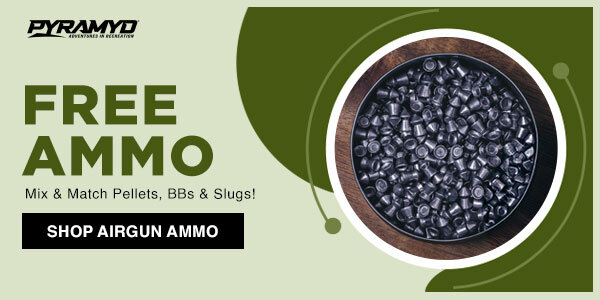
B.B.,
Interesting testing and some nice VICE shooting.
Speaking of vices is that one mounted on some sort of adjustable vibration isolation block system?
shootski
Shootski,
Looks like a heavy vise mounted on magnetically locked blocks. That way they can adjust and then lock it down when they are satisfied with the position.
Siraniko
shootski,
Those blocks are magnetic and used to adjust the vise’s position.
BB
Maybe I should try to get some of those.
B.B.,
Thank you for the vice mount information.
shootski
B.B.
Oh boy, changing barrels, changing scopes, changing moderators….
I’m tired just thinking about it. So many changes, but still accurate!
Yes, get the new tank!
-Yogi
Yogi,
Yep. I do think I need to test the new tank but before I do I hope to shoot at 100 yards with this one.
BB
Wow, bypass 50 and go the distance. It currently is shooting at 1 MOA.
It will be interesting to see it it can do that at 100.
Yes, turn that power wheel up!
-W
Thanks for the well-done report. Looking forward to the next one. If you have a photo of the new barrel without the FATS device attached, please show it to us. I think I understand what you described as the differences from the old barrel. But I think that a photo might be helpful.
Elmer,
It’s difficult to see the differences between the old barrel and the new one, other than the bushings that I showed in Part 1. And of course I showed the barrel without the FATS attached in Part 2.
BB
Thanks, I looked back and saw the photos of the different bushings. That seems to explain things to me.
I have not pulled the barrel on my .20 Condor yet. I do not know if the bushings are delrin or aluminium. Mine as the old style tank with no gauge and foster fitting which means I have to remove it each time to fill it.
A couple of minor boo boos.
The test – first sentence
I shot five-shot groups with each pellet, first with the rifle not silenced, then with the DonnyFL Ronin silencer on (on-delete repeated word) and finally with the TalonP silencer on.
I shot three different pellets – fourth sentence
Let’s look and (at) the first test.
RR,
I’d bet money that your barrel bushings are Delrin and not aluminum. The old tank tells me the age of the rifle and the new bushings were put on well after that. Still, things can be changed with AirForce guns, so you need to look to be sure.
Made the corrections. Good catches!
BB
You put a lot of effort into this one, Tom. It shows. Impressive accuracy achieved, more so because changing suppressors and pellets for each test obviously introduced more of those things-can-go-wrong variables yet things remained, as you stated, consistent. FM now understands why Lothar Walter barrels are a Big Deal – the LW-equipped Marauder is helping him get to Sniper Level though FM will never be at Carlos Hathcock/Chris Kyle Level.
FawltyManuel,
“FM now understands why Lothar Walter barrels are a Big Deal – ” i second your comment!
It isn’t just the accuracy of the individual barrels but the consistency over different calibers as well as all the years that back the Lothar Walther reputation. May they continue.
The Crosman Challenger 2021 with Lothar Walther barrel that i just unboxed appears to have the magic. HAM noted in their Review that their example had the best looking bore that they had ever examined; the same can be said of my Challenger’s bore.
I hope the move/and change in ownership doesn’t derail the reputation and precision of the Challenger!
I have only mounted the Diopter Sight System and adjusted nothing else on the rifle. I set up my trap at 10M and sat in a folding chair to do some unrested shooting to “Break in the Shooter” The initial sight in took two adjustments of 15 Left Windage clicks followed by 5 Right clicks to be centered on the target. During sight in i was shooting 3 Meisterkugeln 8.2 grain groups and at least a third of them were making one hole! I ran out of the old tim of pellets and had to switch to a new tin of RWS R10s that gave me a Pinwheel.
I can NOT wait to get the length of pull and cheek rest adjusted to see what this rifle and Lothar Walther barrel can actually do; i strongly suspect that it will easily out shoot me. :^)
shootski
Are your targets the 10-meter air rifle targets? If so, when the aiming black is perfectly centered in the sights, the contrast between the black and the surrounding lighter color increases noticeably. Having proper lighting of the target helps also. I think the sights are just as important as the barrel when it comes to accuracy.
Elmer,
Yes. They are 10M rifle targets.
BB
Elmer Fudd,
I used the NRA A-36 50 FT. Target (10 Bulls and 2 Sighter Bulls) since a pack of them were sitting on my bench. I wasn’t going to take much time to change the LOP or Cheek Rest or to swap out the front elements to get the best sliver of light around the black. Shooting Off Hand while sitting in a folding chair with cloth seating surface wasn’t going to be very stable anyway.
I just wanted to get get some pellets through the bore, mostly sighted in, and get an approximation of the Challenger’s potential in my hands; the included electronic target report looks to be believable.
I will be using a 10M Air Rifle Target when i take the time to get out my DOA Bench, shooting rest and bags as well as the LabRADAR. But first things first i will be adjusting the LOP and Cheek Rest for the Three Positions before i do any Bench testing. I really do believe in the Natural Point of Aim School of Shooting!
The trigger is probably the last thing i will give any attention as it is very usable (it has a bit more 1st Stage Take-Up than i prefer…) as it came from Crosman.
shootski
Elmer Fudd,
I had a bunch of errands to run today but kept thinking about this statement of yours:
“I think the sights are just as important as the barrel when it comes to accuracy.”
It really bothered me. I have always believed that a barrel that lacks accuracy/precision cannot be overcome by anything WHATSOEVER other than a very long run of LUCKY shots.
I base my premise on the observation that if the barrel is unable, for whatever reason, to precisely and repeatedly deliver projectiles to the same Point Of Impact (POI) that no matter how well the shooter is able to hold the Point Of Aim (POA) with the sight system the shooting implement CAN NOT not be repeatedly accurate.
So yes i agree with you that the sights are a very important item in the quest for accurate shooting but if the sight system is removed from the accuracy/precision system by a Vice (as Tom did for this test) or a Ransom Rest https://ransomrest.com then it is the barrel that determines precision delivery of the projectile…or NOT.
Elmer and READERSHIP:
Let the objections begin…if there are any?
shootski
I agree with your assessment shootski. Perhaps my statement needed some clarification. When I said “just as important as the barrel” I didn’t mean to imply that the barrel wasn’t important. I believe that both the barrel and the sights are important.
Just as a Lothar Walther barrel is typically superior (for accuracy) to most other less expensive barrels, I think that precision sights such as those that come on the Crosman Challenger (and even more expensive 10-meter competition type rifles) are superior (for accuracy) than say the typical open iron sights that might come on a sporting rifle. I find the differences (that make competition sights superior in accuracy) to be interesting and somewhat surprising in how accurate they can be.
No improvement in accuracy with the vice. Then, in your hands, a vice is totally unnecessary but like you said it did save time.
It may however have avoided some change in point of impact or accuracy with the change in moderator and weight you may have avoided adapting to if you held it.
Glad you enabled me to go for broke and order an AirForce rifle early on for my collection. Especially now with the Bounty Hunter Condor and A/F moderator discontinued. No regrets!
Bob M,
Shipmate YOU NEED THIS ONE TOO!
https://airforceairguns.com/product/condor-with-threaded-slug-barrel/
shootski
Shootski,
Would consider it but my Western Sidewinder shoots slugs as well. The barrel alone sounds better.